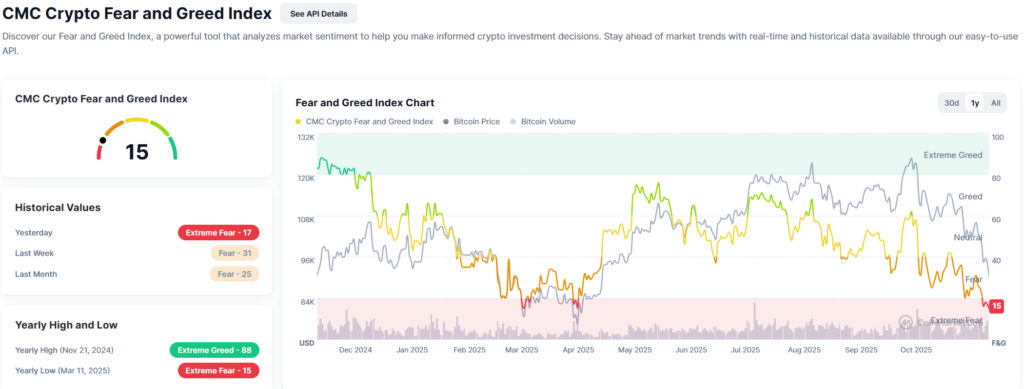Bitcoin tumbled below $90,000 on Tuesday for the first time in seven months, deepening a month-long selloff that has erased all of the cryptocurrency’s 2025 gains and rattled sentiment across global markets. The slide accelerated during Asian trading hours as investors pulled back from risk assets ahead of a high-stakes week dominated by Nvidia’s earnings and the long-delayed US jobs report.
Related: Stocks Slide as S&P 500 and Nasdaq Break Below Key Support
Bitcoin fell as much as 2–3%, extending the drop from its record high above $126,000 in early October. The move pushed the CoinMarketCap Crypto Fear & Greed Index to 15, its lowest reading since the 2022 bear market, signalling “extreme fear.”

Technical Breakdown Fuels the Decline
The latest leg lower followed a string of technical failures:
• Bitcoin broke below $93,700 over the weekend,
• Fell under its 200-day moving average, and
• Triggered a “death cross”, with the 50-day moving average crossing below the 200-day.
That combination has historically been associated with multi-week drawdowns when liquidity thins and macro uncertainty rises. Analysts now see short-term support in the $86,000–$88,000 range.
ETF Inflows Stall, Institutions Pull Back
A core driver of this year’s rally has flipped into neutral. Inflows into US spot Bitcoin ETFs — which absorbed more than $25 billion earlier in 2025 — have flatlined for nearly two weeks. Corporate buyers that added aggressively to balance sheets earlier in the year have also paused activity.
Joshua Chu, co-chair of the Hong Kong Web3 Association, said the retreat by institutional investors is amplifying the selloff:
“When support thins and macro uncertainty rises, confidence can erode with remarkable speed.”
Crypto-related equities have followed the same pattern. Shares of Strategy (formerly MicroStrategy), Riot Platforms, Mara Holdings, and Coinbase have all dropped sharply alongside Bitcoin.

Macro Pressure Intensifies
The crypto slump comes as broader markets turn defensive. Asian stocks slid more than 2%, their worst performance in a month, and regional tech shares in Japan and South Korea were particularly hit.
US markets are also on edge. Both the S&P 500 and Nasdaq closed below their 50-day moving averages on Monday for the first time since April — a sign the months-long uptrend may be losing strength. Futures point to further weakness as traders brace for Nvidia’s results, which are expected to determine whether the AI trade can continue into 2026.
Meanwhile, doubts around Federal Reserve rate cuts, partly linked to concerns that Trump’s tariff agenda could reignite inflation, have further reduced risk appetite across assets.
Broader Crypto Weakness
Ethereum has fallen nearly 40% from its August peak, while Solana and other high-beta tokens are under even heavier pressure. Market chatter has turned defensive, with traders abandoning altcoins and focusing almost entirely on Bitcoin as nerves rise.
The Fear & Greed index, hovering at 15, reflects the mood. A figure this low often appears during capitulation phases, but also sometimes precedes short-term relief rallies if macro conditions stabilize.
Is This the Start of a Crypto Winter, Or Just a Shakeout?
Some analysts warn that the sharp reversal, just six weeks after Bitcoin’s all-time high, may signal the early stages of a deeper correction, especially if liquidity continues to evaporate and ETF flows fail to resume.
Others argue the turbulence is temporary and largely psychological. Dan Tapiero, founder of 50T Holdings, said part of the usual buying pressure has simply shifted toward stablecoins and tokenized real-world assets.
“The short-term volatility is just noise,” he said. “The long-term fundamentals remain intact.”
For now, all eyes remain on whether Bitcoin can reclaim the $93,000 zone, or whether continued weakness in global markets will pull the world’s largest cryptocurrency toward the next major support at $75,000.
Related: What to Watch in Markets This Week: Nvidia, Big Retail, a Delayed Jobs Report










